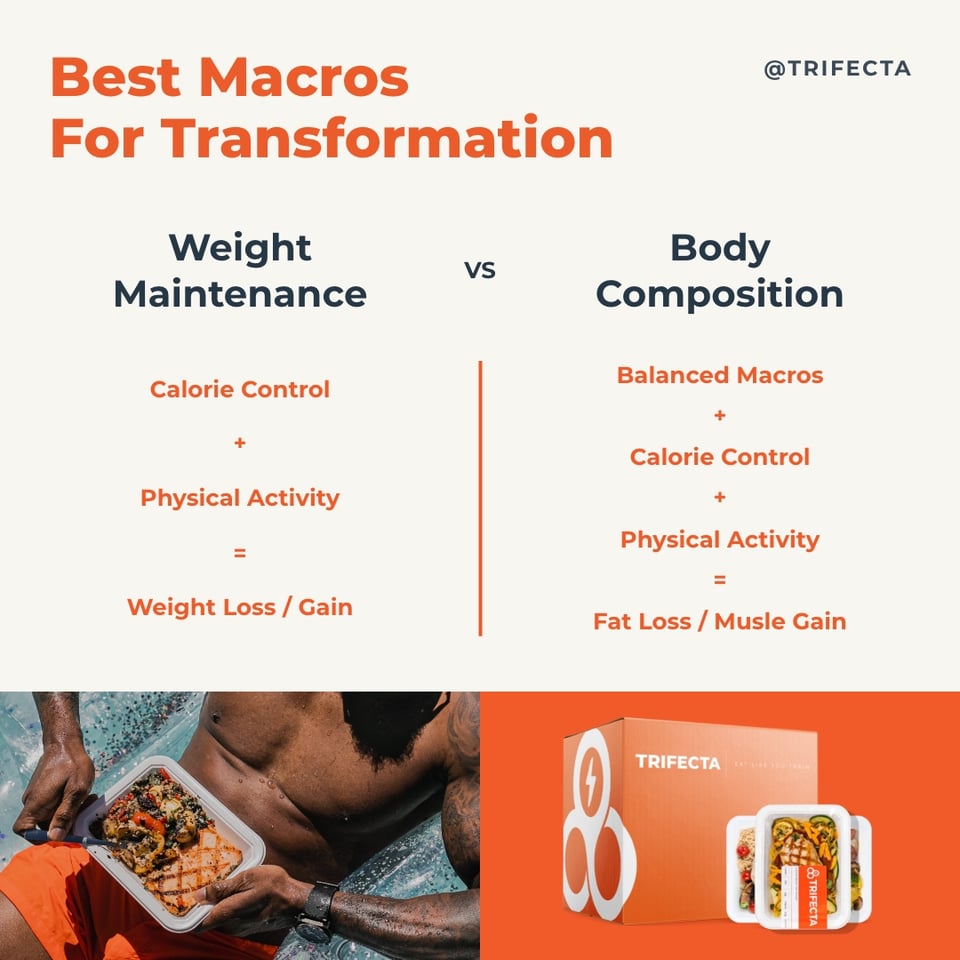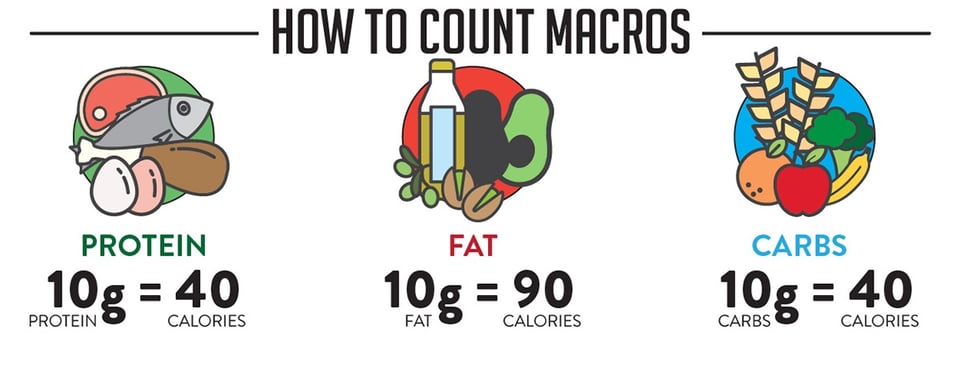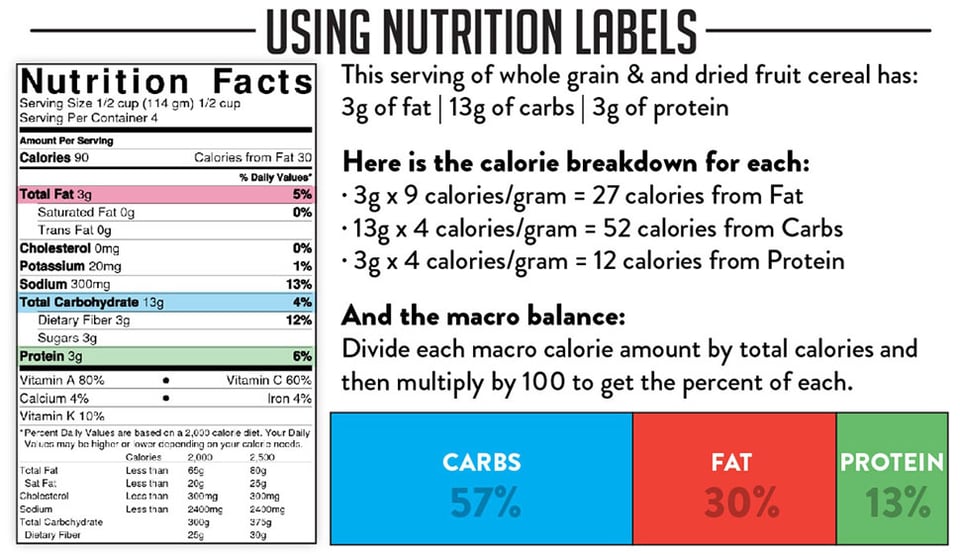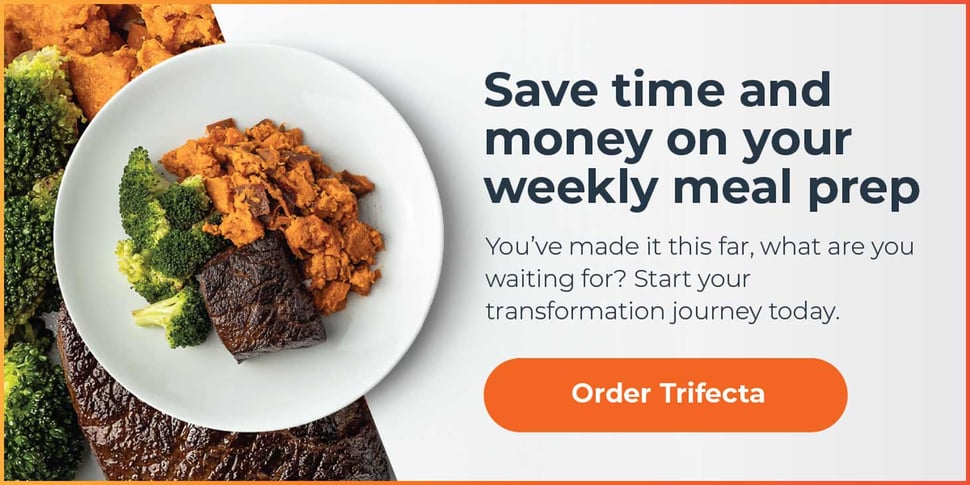Macros also play a part in supporting better energy control, mood balance, appetite, and overall fitness performance.
Carbohydrates
Carbohydrates are the body's quickest and easiest source of fuel, and the preferred source of energy for your brain. They are especially important for high endurance training and explosive strength (needing to be quick on your feet and pushing heavy objects requires carbs). They are also the source of energy your body uses when your fight or flight mode kicks in!
When you eat carbs they are either used for immediate energy or stored in your muscles or liver as a reserve source of energy. When you eat too many carb calories or aren’t using all the carbs you consume, excess carbs can be stored as fat.
Fat
Fat is your source of long-lasting energy and plays a role in supporting good health through nutrient storage and hormone production.
At rest, and during moderate training, the body prefers to use fat for fuel. This is because fat provides more calories for less work (it has twice as many calories per gram as carbs). You can also store a lot more fat for reserve fuel compared to carbs that are limited by muscle and liver capacity.
Calories from fat can be used for immediate energy but, when calories are in excess, fat is stored as body fat.
Protein
Your daily protein needs are directly related to your body weight and fitness level. Protein is the builder nutrient - working to actively maintain, repair, and create just about every single cell in your body.
This is exactly why high protein intake is recommended to help build muscle. Higher protein consumption may also support fat loss.
Learn all about your Macro needs!
Macros vs Calories
Weight loss is achieved by decreasing the quantity of what you eat (aka reducing your daily calorie intake), whereas fat loss requires you to change the quality of your diet. In other words, fat loss or muscle gain can be triggered when you start tracking your macros because of the way your body utilizes them.

Calorie control is the first step in changing your body. Fine-tuning your macronutrient intake is the next level up.
Take this 2-minute quiz to get your personalized macro goals!
Macronutrients vs. Micronutrients
There is a lot of talk around an "if it fits your macros" (iifym) approach to dieting, but macronutrients are only one piece of the puzzle. There are also micros to consider when it comes to nutrition needs.
Micronutrients (micros), on the other hand, are nutrients needed in smaller amounts, and they do not provide a source of calories to the diet. These include all of the essential vitamins and minerals we need each day.
You can likely eat a lot of unhealthy foods and still hit your macros, but you'll get better results if you focus on diet quality as well. I'm talking about choosing more nutrient-dense foods instead of just focusing on your daily macros.
Is Alcohol a Macro?
Alcohol is also technically a macro since it provides calories, but is not considered an essential nutrient for health so it is often left out of macro diet plans.
You should still track your calorie intake from alcohol since this will definitely affect your progress and ability to lose weight or gain muscle. Alcohol provides a significant

If you are looking to lose body fat you may want to consider drinking less alcohol. Your body will prioritize metabolizing toxins from drinking before other macros, slowing down your metabolism and increasing how much fat you are storing from food. This can prevent you from burning as much fat.
How to Count Macros
Counting macros is the process of tracking how many grams of each macronutrient you consume per day. And because protein, fat, and carbohydrates each provide a certain amount of calories per gram, you are also tracking how many calories per day you consume.
Counting macros is an easy way to count calories and nutrition intake at the same time.
Make following a macro diet easy! Get our Free Ultimate Meal Prep Guide for a step-by-step plan to optimize your fat loss and muscle gain.
Once you know your calorie goals, you can easily count your macros using the following three steps:
Step 1. Learn How Many Calories Per Macro
The calorie breakdown of your macros is as follows:
Carbohydrates and protein provide roughly four calories per gram - meaning a food or beverage item with 10g of protein will provide 40 calories from protein.
Fat is the highest calorie nutrient with nine calories for every gram - more than twice the amount of energy as protein and carbohydrates. Thus, a food or beverage containing 10g of fat will provide 90 calories from fat.

Step 2. Calculate Total Macro Calories
You can calculate the amount you are eating by using the nutrition facts label. It really is that simple, anything that has a nutrition facts label also has macronutrients listed. In fact, this is exactly what the FDA uses to calculate the number of calories in your food.
For example, the nutrition label for a half-cup serving of whole-grain cereal says it provides 3 grams of fat, 13 grams of carbs, and 3 grams of protein. You can calculate the calories for each macro by multiplying each by their designated macronutrient calorie count.
- 3g of fat x 9 calories per gram = 27 calories
- 13g of carbs x 4 calories per gram = 52 calories
- 3g of protein x 4 calories per gram = 12 calories
These calorie amounts combined should equal the number of total calories for the food - 90 calories per serving!
Step 3. Assess Macro Ratio (%)
To find the macro ratio percentage for each, you simply divide each calorie amount by total calories (90) and then multiply by 100.
Note: this percentage is different from the percent daily value on the label, which is looking at your total daily needs.
- 27 fat calories / 90 calories x 100% = 30% of calories from fat
- 52 carb calories / 90 calories x 100% = 57% of calories from carbs
- 12 protein calories / 90 calories x 100% = 13% of calories from protein
The percentage of all three - protein, fat and carbohydrates, should total 100%.

TIP: To be as accurate as possible, make sure you are measuring for the right portion size!
Using a Macro Tracking App
In short, the easiest and most useful way to count macronutrients is using a macro tracking app. It's also a good way to ensure you are sticking to your diet so that you get results!
Tracking apps can be especially helpful for options that don’t have a nutrition facts label - such as fresh meats and produce. Using a searchable database from a food-tracking app can help you find the nutrition breakdown of these foods.
You can also find the nutrition information for any food online through the USDA Food Composition Databases.
Additionally, some tracking apps will use a barcode scanner feature that allows you to quickly input nutrition info for packaged foods.
Pssst...The Trifecta app has over 6 million food items you can search for, plus a barcode scanner for better tracking! It also has a quick add macro feature that allows you to input the carbs, fat, and protein for any food to count your macros in seconds.
TIP: Weighing and measuring your food will help you to be more precise, when tracking items without a nutrition facts label.
How Many Macros Do You Need?
Through a series of simple questions to assess your activity level and health goals, you can quickly determine your macro needs using a macro calculator.
Or you can roughly estimate your macros using the simple formula below.
Step #1 - Choose your objective. Are you trying to lose fat, gain muscle, or do you want to maintain your weight and/or improve performance?
Step #2 - Estimate how many calories you need per day to lose, gain, or maintain your weight. You can find this using a total daily energy expenditure calculator or TDEE calculator.
Step #3 - Once you have your target total daily intake, you can estimate your macro needs using the following chart:
f807.jpg)
Macro Diets
Macros are not always a one-size-fits-all approach. There are a number of flexible dieting options you can use to control calories and balance your nutrition by counting your carb, fat, and/or protein intake.
Whether you are a bodybuilder, or just looking to eat healthier, here are some common macro-based approaches you might have heard of:
Weight Loss Macros
In reality, you can lose weight on any diet as long as you stay in a consistent calorie deficit. Meaning the number of calories you eat each day is below your total daily energy expenditure (TDEE). Counting your macros for weight loss just means determining what type of macro split best fits your goals and keeps you in a sustainable deficit while learning how to optimize the quality of your choices!
Wondering if low carb, high protein, or low fat is best? Here are the best macros for weight loss to get you started.
Macros for Cutting
Elite athletes and bodybuilders often use the process of diet periodization, in which they intentionally plan to cycle through phases of cutting (weight loss), bulking (weight gain), and maintenance to achieve a specific physique while training.
Each of these phases requires a personalized and unique macro split to reach the desired physique goals. It's a bit more complicated than being in a calorie deficit for weight
In the cutting phase, the goal is to lose body fat while maintaining as much lean mass as possible (aka get shredded).
Looking to maintain lean mass and get shredded? Check out this simple guide to macros for cutting and dial in your nutrition like a pro.
Muscle Gain Macros
Bulking just means more muscle, not always getting “big”. And every pound of muscle on your body is really worth keeping around. The top reasons to think about trying a weight gain diet include:
- Increased lean mass
- Improved strength and performance
- Easier weight maintenance
Cycling through cutting and bulking phases is often used as a way to systematize and fine-tune your fitness approach. Since a bulk can result in somebody's fat gain, most will follow this with a cut to slim down and shed any unwanted body weight, while maintaining lean mass.
Gaining healthy weight requires a strategic macro and training focus. Get up to speed on the ideal macros for bulking to make sure you put those gym days to work.
Keto Diet Macros
Keto macros are different from normal macros since the keto diet requires a higher intake of healthy fats and a low intake of carbohydrates to promote ketosis.
Have trouble sticking to a lower fat intake? Consider changing it up with a high-fat, low-carb diet for weight loss like keto. Check out this keto macro guide to get started.
Vegan Macros
Since plants are typically a source of carbs and/or fats, navigating a high protein, plant-based diet can feel challenging since the "traditional" food plate stacked with meat, grains, and veggies looks a little different on a plant-based regimen.
Vegan diets exclude the common sources of protein - meat, and dairy, and rely solely on plants for complete nutrition. Plants tend to be a source of multiple macronutrients all at once, which can blur the line between a protein, carb, or fat choice. Nonetheless, with a little portion adjusting and practice, it’s entirely possible to hit your macro diet goals and get the results you’re looking for on a vegan meal plan.
Learn more about how to count macros on a vegan diet.
Macro Meal Planning
Once you’ve got your macronutrient ratios dialed in, you can plan your daily meal plan around them.
Here’s how to build a solid menu to reach your goals:
- Start by learning which healthy foods correspond to each macronutrient.
- Then get familiar with weighing and portioning your food with this portioning guide.
- Learn to meal prep like a boss to crush your macros and eat the foods you love most.
- Track your daily intake using a food tracking app.




